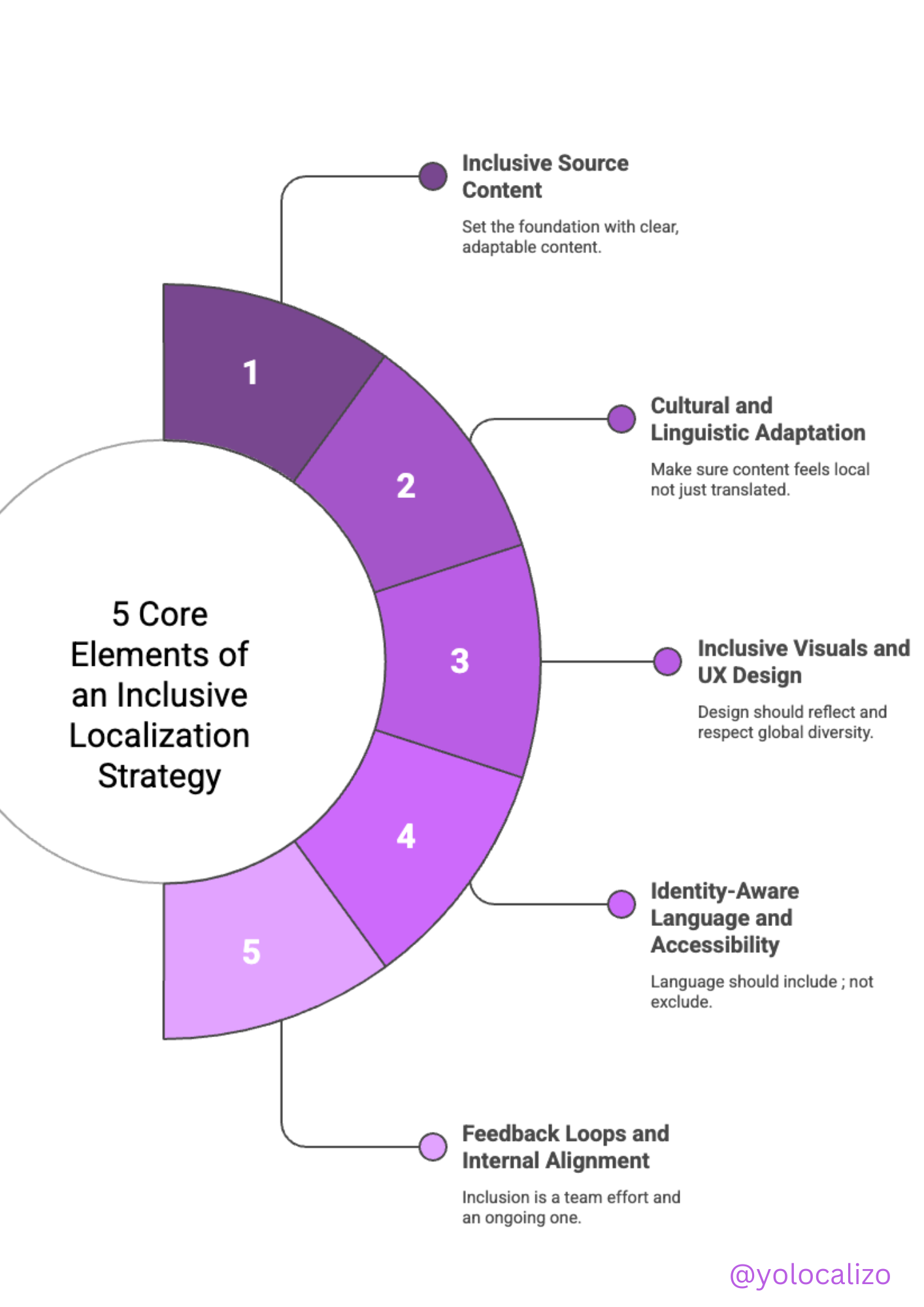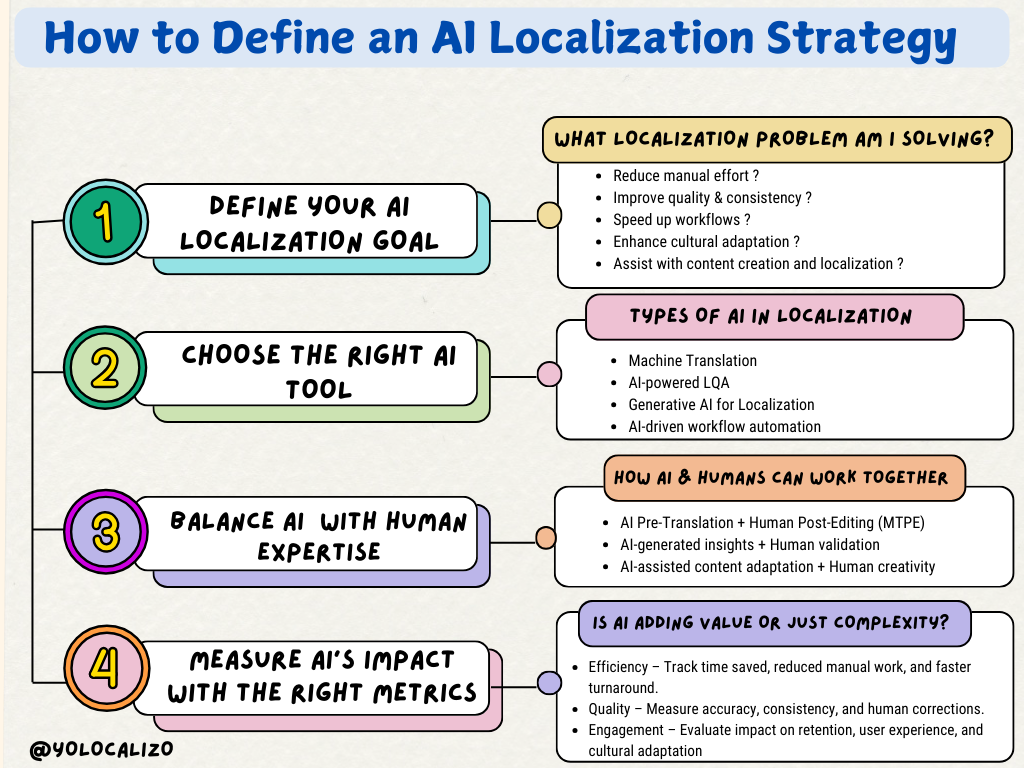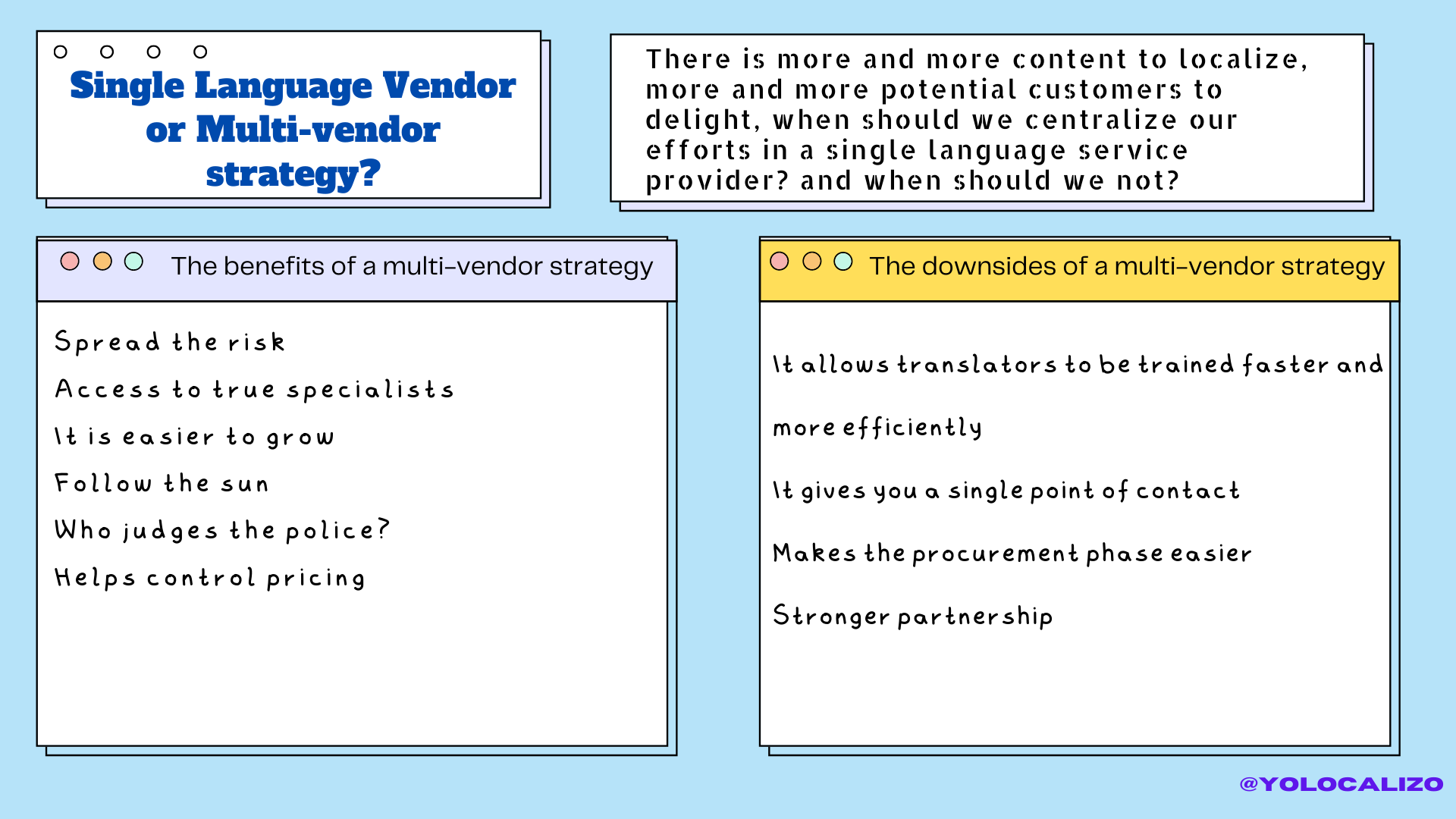Do you know when to go with a Single Language Vendor or Multi-vendor strategy?
I don't know if there is any industry in the world with as many possible working models as our localization industry.
Freelancers, Linguisics, internal localization teams, we also have the Single Language Vendor, the Multi-Lingual Vendor, crowdsourcing ... that's quite a lot already, but wait! there's more! As if that was not enough, we can have internal localization teams as shared services, embedded in Development teams, or as part of marketing or distributed in different territories under the country manager ... what a mess!
All these topics, to a greater or lesser extent I covered in this blog; there will be some of those topics that I will dust off and update them as there are new things that I think it may be relevant to cover; today in particular, I want to talk about the advantages and possible disadvantages offered by a Localization model in which our main partner is an MLV.
A Single Language Vendor (SLV) provides translation and linguistic services in a specific language combination. SLVs are usually freelance translators specialized in a particular language pair (English to Spanish, for example) who work together in one company. SLVs can work independently or as part of a larger LSP.
The SLVs is usually set up as a company offering a wide range of translation services such as
translation, editing, proofreading, and quality control
file preparation and engineering
project management
desktop publishing etc
Their services and role are actually quite similar to that of MLVs, but we must remember that an SLV works only in a couple of languages.
A Multilingual Language Vendor(MLV) usually offers a wide range of translation services in several languages, allowing its clients to concentrate all their translation requests in a single vendor, regardless of the language.
The services of an SLV and MLV are similar, but of course, as MLVs are larger, it is not uncommon to find in an MLV more services related to translation technologies. Such as MT, Data for AI, Chatbot systems, or Localization sentiment analysis, among others.
When we analyze both models, we can find certain behavioral patterns or expectations.
Generally speaking, with a Single language vendor strategy, we will experience a more personal approach when working with a small company. We are more likely to receive individual attention with a small language service provider than with a language service provider that has thousands of active clients. A smaller company may be more flexible and will more easily plug into your existing workflow as an extension of your team.
However, with a multiple language vendor strategies, we will be in a better position to meet complex requirements either because the number of languages is high, the language combination is atypical, or the deadlines are aggressive. An MLV has a large structure and condenses different services so it can be a very valid option for certain projects.
There is no general recommendation as to when one model is better than another. It depends a lot on each client and their Localization needs. Each client is different, however, there are a series of parameters that we can consider and see if the balance is tipped to one side or the other.
The benefits of a multi-vendor strategy start with
1. Spread the risk
All eggs in the same basket do not sound like a very safe approach. What if the vendor is missing some key deliveries? What if they decide to increase their rates, or even worse, what if they go out of the business. One of the main reasons organizations opt for a multi-vendor strategy is to spread their risk.
2. Access to true specialists
It is difficult for a translator to specialize in a wide variety of fields, if you specialize in video games it is difficult for you to do an impeccable job in a legal translation, or in a life science translation, in Spanish there is a saying that is "zapatero, a tus zapatos" (Stick to what you know ... which I think represents very well what I want to express at this point)
3. It is easier to grow
If your Localization program is going well and if your product is doing well, it is quite likely that we will have to localize a high volume of content, or the workload for whatever reason may be very variable, and there are weeks or even days when the workload may be very high and at other times not so high. In situations like this, one single vendor may struggle to scale their efforts at the speed we need. When one vendor may struggle to scale their efforts at the pace we need, it can be better to spread projects across multiple vendors.
4. Follow the sun
The world does not stand still, and today we are more connected than ever. MLV is present in multiple geographies. And that is a very interesting factor when choosing one partner or another. An MLV can offer linguistic solutions under the same roof starting in Asia, advancing in Europe, and continuing in America.
5. Who judges the police?
Having different vendors on hand that we can use for cross-checking is very useful to make sure that there is no drop in the level of quality we desire
6. Helps control pricing
A multi-vendor strategy allows us to have a little more control over the prices we can aim for in our Globalization strategy. When we have several vendors at hand, comparing prices is a more accessible activity.
What are the downsides of a multi-vendor strategy?
While there are many benefits to having a multi-vendor localization strategy, there are also potential issues. It can be inefficient in terms of costs and management time, for example, to have different areas of your business using other LSPs on an ad hoc basis for similar services.
There's also the danger of inconsistencies in quality and linguistics arising from a decentralized approach. And a multi-vendor localization program can be very complex to manage. If it isn't managed carefully, it can lead to oversights such as web pages or other assets not adequately maintained in local languages.
Let's see these downsides in more detail.
.1. It allows translators to be trained faster and more efficiently
A single-vendor strategy ensures that the localization specialist can get up-to-speed quickly, whether they're new or just learning something new. It'll be easier for you to onboard new translators, train existing ones, and explain the features or context of the product you want to localize. By doing this, you build knowledge in the long run, and you create real experts
2. It gives you a single point of contact
.With a single vendor, you have one single point of contact to get your answer. Questions can be answered faster than multi-vendor strategies, which often require that you submit emails, chat or do different calls to get an update
3. Makes the procurement phase easier
Choosing vendors takes time. Organizing RFPs, reading RFPs, selecting finalists ...it's a time-consuming and tedious process.
Choosing one provider is a lot simpler than choosing one service from many providers.
Not everyone needs more than one vendor, so if you have a localization program that allows you to cover your core activities with one vendor, why complicate your life?
4. Efficient invoicing is also a good reason for avoiding multi-vendor strategy. You will no longer have to collate various invoices and payment receipts for numerous suppliers as you will only deal with one account and one vendor. Sometimes, reviewing POs can be pretty tedious and take more administration time than we would like. All this bureaucracy is considerably reduced if we centralize all invoicing tasks in a single provider.
5.-Stronger partnership - when we work continuously with a single partner, it is inevitable that sooner or later, we will establish a very good relationship with our contact and the company they represent. It is easier to invest time in building a good relationship when we have one contact than when we have several. And undoubtedly there are multiple occasions in which that relationship of proximity, of familiarity will result in a better service and in many occasions it will result in a better quality.
The language service providers are the backbone of our Localization strategy to guarantee our international customers the best user experience. Some people think that less is more, others that more is more and that less is boring :) The elements I have summarized above must be weighed in the balance to make the best decision whether to have a single provider or to have a diversity of providers.
I hope you found this post helpful!
@yolocalizo













Before jumping on the AI bandwagon: What localization problem are you trying to solve? AI is everywhere right now, including in localization.
But before jumping on the bandwagon, we need to stop and ask:
Are we solving the right problem?